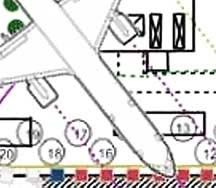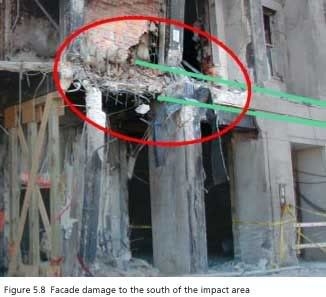BEING A FASCINATING STUDY OF FIRST-FLOOR COLUMNS 15AA-17AA
Adam Larson/Caustic Logic
The Frustrating Fraud
Split-off July 3 2007 from Support Columns masterlist
 This photograph by James Ingersoll was used as figure 3.9 in the ASCE’s Pentagon Building Performance Report. It shows exterior support columns 15AA, 16AA, and 17AA, which the report described as “severely distorted but still attached at least at their top ends to the second-floor framing.” [1] This is what I originally saw as well, as have most others. But being just to the immediate left of the main fuselage impact point at column line 14, this should have been the entry point for the right engine and wing root; it stands to reason then they should have been just as removed as the columns to the left of 14.
This photograph by James Ingersoll was used as figure 3.9 in the ASCE’s Pentagon Building Performance Report. It shows exterior support columns 15AA, 16AA, and 17AA, which the report described as “severely distorted but still attached at least at their top ends to the second-floor framing.” [1] This is what I originally saw as well, as have most others. But being just to the immediate left of the main fuselage impact point at column line 14, this should have been the entry point for the right engine and wing root; it stands to reason then they should have been just as removed as the columns to the left of 14.  |
This is classic fraud logic. “there was no 757 because the hole is too small. The “extra damage” is because of explosions to make it look like a bigger 757 hole. But just looking at that hole, you can see it’s too small…" (rinse and repeat).
However, looking at that diagram and noting that everyone agrees that the outermost columns on the left and center of the entry space (10-14AA) were uniformly removed, #15 and 16 indeed should have been nearly vaporized. This never seemed a big enough problem for me to dismiss the 757 hypothesis; I figured the displacement was enough to let an engine pass, but I found it odd that 16 would just "tip over" in straight form rather than being bowed. When I realized the high-right banking angle as well, it became clear this column would have been hit near the top, not the bottom, which makes no sense given the pictured slant of this big, square-sided "damaged column." And I was at least half-aware that the columns the ASCE and I were seeing looked different from each other and from the other pillars we can see, and weren’t quite properly spaced.
In retrospect it was also a bit sloppy of me – and perhaps the ASCE - to be certain these were "support columns" at all. In fact, despite their impressive credentials, no one at ASCE had time to look up close before the collapse, and only so much could be told afterward. in the collapse zone “the team was unable to determine specifically the level and extent of impact damage.” [3] They probably decided on the pillars by looking at these photos – but Jim Hoffman has looked at the same ones and decided “some or all of these objects may in fact be broken portions of the second floor slab that collapsed after the impact,” and came to rest at an angle close enough to vertical to be mistaken for columns. [4] Note also the lowest edge of the 2nd floor façade between 15 and 16 missing a segment of limestone about the size of “column 16.”

Another shot, above, from before the area's blanketing in foam reveals the burning hell a Pentagon doused in jet fuel becomes, as well as better detail on the possible pillars. Here it seems #15 and #17 are just narrow bits of something dangling down nearly to the ground, but these could be battered pillars, reduced to rebar netting. #16 looks most like a solid pillar on first blush, but much burlier than #18 or the other suspects, and I doubt it would look this clean and square if it’d been hit by an airliner at it's "still attached" top end.
 |
 Note: “Column 16” appears wider in the original photo, but I noted a light line running down the middle of it, indicating it had a square cross-section, and had somehow rotated about 45 degrees from the camera. When placing it above I “turned it around” by cropping off one side, but then failed to stretch it back out to cancel the perspective. I’ll have to correct this. But anyway, I still say whatever horizontal member this might’ve been, it makes more sense than a column that had been hit by any part of a barreling 757.
Note: “Column 16” appears wider in the original photo, but I noted a light line running down the middle of it, indicating it had a square cross-section, and had somehow rotated about 45 degrees from the camera. When placing it above I “turned it around” by cropping off one side, but then failed to stretch it back out to cancel the perspective. I’ll have to correct this. But anyway, I still say whatever horizontal member this might’ve been, it makes more sense than a column that had been hit by any part of a barreling 757.  A still from the PBPR, a 3-D model by the ASCE. The three red slants here are columns 15-17. Among the worst damaged, these are listed in the Performance Report as “missing, broken, disconnected,” elsewhere described as "without remaining function.” Some were entirely knocked loose but found, some were disconnected but standing, and some totally obliterated, here represented by dots on the floor where they were. These red “columns” appear out of place when all those around and behind it are verified or presumed vanished. I suspect this graphic is incorrect by having the three red pillars shown as anything but dots.
A still from the PBPR, a 3-D model by the ASCE. The three red slants here are columns 15-17. Among the worst damaged, these are listed in the Performance Report as “missing, broken, disconnected,” elsewhere described as "without remaining function.” Some were entirely knocked loose but found, some were disconnected but standing, and some totally obliterated, here represented by dots on the floor where they were. These red “columns” appear out of place when all those around and behind it are verified or presumed vanished. I suspect this graphic is incorrect by having the three red pillars shown as anything but dots. If these three mystery slants are indeed something other than columns 15-17, then we are left with a roughly 90 foot-wide area in which all supports were obliterated on the ground floor, front line - leaving plenty of room for the engine-fuselage-engine penetrating core of a 757, whose deeper but less even damage further in would explain the collapse of everything above that twenty minutes later. While some confusion about this has encouraged speculation and no-757 theories, a little research would show that in either analysis, red is red; missing or in place but non-functional, these columns are no longer functioning support columns because something heavy and fast has traumatized them.
Sources:
[1], [3] Mlakar, Paul et al. “The Pentagon Building Performance Report.” American Society of Civil Engineers. January 2003. PDF version. www.fire.nist.gov/bfrlpubs/build03/PDF/b03017.pdf
[2] Eastman, Dick. "You Decide: Fighter Jet? Or 757? 911 Pentagon Crash Evidence proves False-Flag Frame-up." http://www.bedoper.com/eastman/
[4] Hoffman, Jim. “ERROR: 'Surviving Columns Preclude 757 Crash'” 811 Review.com http://911review.com/errors/pentagon/columns.html









No comments:
Post a Comment